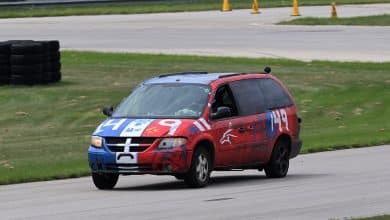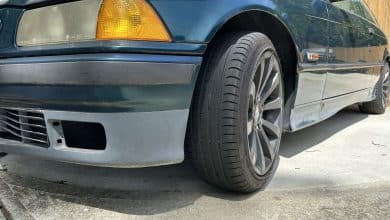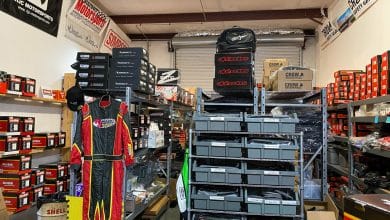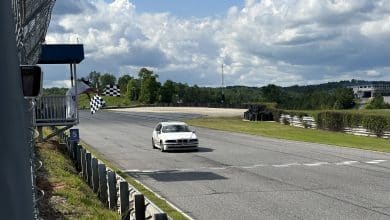Running Lucky Dog With A Champ Car

As you may know by now the team here at ShiftAtlanta built an endurance car, Team Nein Blinker. We did this because we wanted to show what would happen when 4 relatively typical car enthusiasts tried to build a race car. Our team has varying degrees of experience, but zero with endurance racing. While it showed through our many painful mistakes and regrets, we also showed it was possible.
Now going on 3+ years of racing, including a podium finish, we’re out to share what we have learned through our experience and by gathering the knowledge of others about the endurance racing scene. Part of that experience has been running in the Lucky Dog’s series.
Most of the entries into Lucky Dogs came from cars that also run in 24 Hours Of Lemons or Champ (Chump) Car. So it’s not uncommon for cars to try to make the move. However, there are a few details to pay attention to if you are looking to make the move or are building a car to run multiple series.
Lucky Dogs Racing
Lucky Dogs Racing is an endurance series primarily focused on the pacific northwest, though they are building a significant presence in the southeast. Slotted as more driver focused series than 24 Hours Of Lemons and but with more freedom of build than Champ Car the series, Lucky Dog fills a needed niche in the amateur endurance racing scene. One that is competitive, but still very accessible and approachable.
Southern Endurance Cup

For 2023 the Lucky Dog Endurance Series that runs here in the Southeast is known as the Southern Endurance Cup. It’s is three races, two at Carolina Motorsports Park (February and September) and one at Atlanta Motorsports Park in May.
Champ vs. Lucky Dogs Rules Differences
The good news if you currently run in Champ car is that Lucky Dogs has simpler tech and safety rules, so there isn’t a lot of changes you’ll need to make. We are going to talk through all of the ones that would matter in order to run Lucky Dogs.
Car Entry Requirements
While Champ Car focuses speed and competitiveness of the car and it’s modifications, expressed in VPI , Lucky Dog focuses purely on the year. In Lucky Dogs any car 2006 or older is allowed in. Yes, you could take a 2005 Ferrari and strip the interior, put in a roll cage and run it. While to the best of our knowledge nobody has done that yet, at some of the largest races there often Porsches, V8 Mustangs and Corvettes running in the top classes.
There are few to no limits on modifications as well. So unlike Champ car where there are points assigned for things like coil overs, Lucky Dogs encourages you to build the car you want to build.
Competitive Classes In Lucky Dog
You may wonder how Lucky Dog’s keeps a competitive balance then. It does it a few ways.
- Tires (spec tire) limits total overall speed
- Classes based on qualifying speed
- Maximum speed based on highest predicted lap time based on the overall field to keep speed differential in check (known as the super dog time)
While for the very fastest cars there is a risk you will be throttled by the limited fastest lap time, for MOST builds, this allows all competitors in each of the classes to run within a ~5 seconds a lap of each other. This puts the focus on pit times, pit strategy and staying on track rather than buying wins with parts or tires.
Spec Tires and Sponsors
Another significant difference between Champ and Lucky Dogs is the spec tire. All competitors must run Hankook RS4s, and they must be purchased through directly from Hankook via a special portal. If you choose not to you’ll be placed in an exhibition class and won’t be eligible to accrue points or win trophies.
One other note on car entry is stickers. Lucky Dog’s has a number of sponsors and requires all cars to run stickers of their sponsors. While we had no issue with this, some teams grumbled at not only the sticker requirement – but the sear number of them. There were about 10 sponsor stickers we had to place on the car.
Safety Rules Differences
There are not significant safety equipment differences between Champ and Lucky Dogs. If anything, there are few safety gears requirements in Lucky Dogs. Though that doesn’t mean Lucky Dog’s isn’t a safe series. Lucky Dog’s stresses they are a no contact series, which is how they limit even the opportunity for a lot of potential incidents.
Other Rules Differences
The only other significant rules difference most Champ cars face when moving to lucky dogs is the fuel cell rule. In Lucky Dogs there is a flat maximum 24 gal fuel cell that applies to all cards. In Champ car you are limited to 2 gal more than stock fuel tank size. So in most instances Lucky Dogs is actually more accommodating. However, if you had a really large factory tank it technically possible to run up on the maximum. Though we struggle to think of too many practical examples.
About Team Nein Blinker
Team Nein Blinker is ShiftAtlanta’s Community project endurance race car. Our goal is to show what the experience is when a team of typical car enthusiasts build an endurance race car. The good, the bad and the ugly.
Our goal with the team and the car is to bring more people into driving events – including autocross, sprint racing and endurance racing. Follow along with our adventures.





